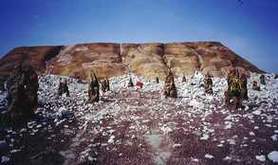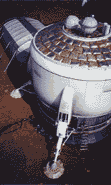Mission To Mars
Red Horizon Production/ Disney
As Head Sculptor I
had lots to do. Building the spacecraft required nothing less than
a factory style approach to their construction. Hundreds of mechanical
parts had to be fabricated and sculpted to be moulded then cast
into multiples to facilitate the NASA hardware look to interiors
and exterior set pieces. All construction departments contributed
to this end, requiring a good level of communication and flow of
information.
All that worked on
'Mission to Mars', among them many seasoned veterans were surprised
how well it all went. From my point of view it was the level field
created by the designer, his art directors and the contributing
departments on the show. It would be nice if they all went so smoothly.
The Martian exterior
was the choice challenge for me on this one. I did love the technical
problem solving of the spacecraft hardware, but being out there..
on Mars was where I liked it the most. Reminding me of my 'Alive'
experience it required the creation of a believably realistic physical
setting.
The design of the Martian
exterior called for more than 20 acres of a sandfill to be transformed
into a Martian landscape for 3 or 4 separate areas all sharing angles
of view. The main feature and the largest was a hillside 40 feet
high and 200 feet long. This hillside would serve as a 'template'
for the visual effects department to build a mile high cliff face
for the revealing of the alien craft. Just for fun the Director
Brian DePalma wanted some weird features to be created in front
of this structure, so the 'hoodoo' concept was settled on. Over
200 of these were directly carved in polystyrene and place in front
of the sculpted hillside.
 |
 |
The hillside itself
was created from an existing sandpile. My experience as a competition
sand-castle builder came handy here. After a few tests were run,
I discovered the sand to be used had a good platelet like grain
and just enough silt content to allow us to build up steep faces
without the threat of collapse. It did mean having to compact the
sand with pressure (tamping) while keeping the sand wet, as I'd
done in sandcastling before, the hill was built in 'lifts' - 10
foot sections which were completed one lift at a time. To complete
a lift required first compacting, then sculpting (reference to a
1" to 1' scale model) and finally sprayed with concrete. A
tricky, but very effective method for stabilizing the sculpted sand
and giving the surface a basic colour. The concrete was then tinted
to red oxide.
 |
 |
Once sculpted and sprayed
with coloured concrete the hillside was 'backfilled' with more sand
- this gave an eroded look overall. On top of this layer, tonnes
of broken concrete debris was strewn. More was spread over the hillside
itself giving yet another layer of erosion - finally the 'hoodoo'
sculptures were placed.
My department, whose
numbers at the peak of the project reached 25, was responsible for
building many aspects of the pre-production. We serviced many other
departments such as Special Effects, Props and Set Decoration: Rubber
Watches, Rubber life support backpacks & 'sack' infill for the
survival sled were just a few of the things we built.
|
